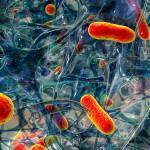Using Stem Cells to Fight Infections in Horses

Biofilms play an important role in antimicrobial resistance and life-threatening treatment failures despite aggressive antibiotic therapy. Novel strategies for breaking up biofilms include stem cell therapy. Preliminary laboratory studies show promise using stem cells to fight infections involving biofilms, but more research is needed before this technique will reach live horses.*
What Are Biofilms?
Biofilms are communities of bacteria that attach to a surface—either a tissue or a surgical implant such as those used in orthopedic surgeries—or to each other and then become encased in a self-secreted matrix composed of carbohydrates, proteins, and DNA. Essentially impenetrable, the biofilm protects the bacteria from antibiotics and even the animal’s own immune system.
“Biofilms shield bacteria, making it very difficult to successfully treat biofilm-associated infections,” explained Kathleen Crandell, Ph.D., a nutritionist for Kentucky Equine Research.
This makes for a dire situation when biofilm infections occur in horses.
“Persistent orthopedic biofilm infections…are often caused by Staphylococcus aureus and Escherichia coli, which readily form biofilms on metallic orthopedic implants and in synovial fluid as floating aggregates. The resulting chronic lameness, loss of athletic potential, and reduced quality of life due to chronic, unresolved orthopedic infections make euthanasia ultimately necessary in up to 54% of horses,” wrote veterinary researchers from Virginia.
They added, “A treatment that disrupts established orthopedic biofilms and improves success of antimicrobials and surgical intervention is desperately needed.”
Creating Biofilms, Testing Stem Cells
Jumping in, the research team created cultures of both S. aureus and E. coli, allowing them to form biofilms. Additionally, mesenchymal stem cells were collected from horses using standard techniques.
The biofilms were then treated/cultured with (1) stem cells alone; (2) stem cells plus the antibiotic amikacin; and (3) amikacin alone. A positive and negative control were also included. Cultures were then analyzed for biofilm size, biomass, and live bacterial counts (measured as colony forming units or CFU).
Results
Stem cells reduced biomass and biofilm area in S. aureus biofilms. The addition of the antibiotic amikacin did not result in a greater decrease in biomass compared to stem cells alone. However, the combination of stem cells and amikacin reduced S. aureus biofilm biomass and area compared to amikacin alone.
“These results suggest a potential synergy between amikacin and stem cells for battling S. aureus biofilms,” Crandell explained.
For E. coli, biofilm area was reduced by stem cells at 24 hours and stem cells plus amikacin at 48 hours compared to no treatment. Stem cells, either with or without amikacin, did not decrease E. coli biomass.
Amikacin and amikacin plus stem cells reduced live bacterial counts in the biofilms (CFU), but stem cells alone did not.
What Was Learned
Stem cells reduced biomass and area in some of the cultures, potentially by reducing biofilm matrix. There were differences between S. aureus and E. coli biofilms, and stem cells affected the E. coli biofilms less than S. aureus biofilms. Disappointingly, the stem cells did not affect live bacterial counts.
“Our results support further investigation of mechanisms by which MSC [stem cells] disrupted biofilm matrix and highlights the importance of targeting specific bacterial strains for optimizing anti-biofilm therapy,” concluded the researchers.
Supporting Horses with Acute Lameness
Acute lameness can occur secondary to joint infection or in emergencies when surgery is required to repair a fracture. In these situations, horses are suddenly taken out of training.
According to Crandell, the unfortunate consequences of extended layups on a horse can be threefold: loss of bone mineral content, digestive disorders such as gastric ulcers, and hindgut acidosis.
“Dietary changes may help mitigate these concerns associated with the sudden lack of activity and stress of confinement. Reducing the quantity of calorically dense concentrates, maybe even switching solely to a ration balancer, will help limit caloric intake to maintain body condition score. Making sure there is ad lib forage available and providing some form of alfalfa, whether hay or pelleted, will help control stomach acid.
Supplementing with Triacton, a Kentucky Equine Research supplement, can support horses by:
- Increasing bone density for skeletal strength;
- Buffering stomach acid to bolster gastric health and reduce the incidence of ulcers; and
- Moderating the pH of the hindgut to prevent acidosis.
“Studies conducted at Kentucky Equine Research demonstrated that Triacton increases bone density among Thoroughbreds in race training. Horses receiving 120 grams per day of Triacton for 90 days had a threefold greater increase in dorsal (shin) cortical bone density compared to the horses that received a placebo,” Crandell explained
*Khatibzadeh, S.M., L.A. Dahlgren, C.C. Caswell, W.A. Ducker, S.R. Were, and S.H. Bogers. 2024. Equine bone marrow-derived mesenchymal stromal cells reduce established S. aureus and E. coli biofilm matrix in vitro. PLoS One 19(10):e0312917.








